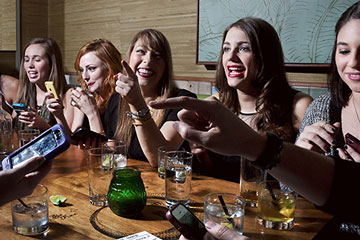
A group of girlfriends gathers at Babys All Right, a Brooklyn bar, to play a Tinder drinking game.
(3 of 4)
Some have turned Tinder into another pastime: the drinking game. One Friday in January, 11 women in their mid- to late 20s gathered around a long table at a bar in Brooklyn to play. At first glance it looked antisocial: heads bowed while hands swiped across phone screens. Then one player punched her phone in the air and announced that she had spotted a guy posing with an unidentified child in his dating profile. "Kid in the picture, and he hasn't specified it's his sister's. Drink!" With loud cheers, the party suddenly turned boisterous as the women called out other rules that mandated a sip. Six women each swiped guys posing with the rapper Drake. Another came across three men posing with sedated tigers ("and a tarantula") in one night. One 25-year-old woman in attendance keeps at it even though she has found a match. She says her boyfriend doesn't mind because she's simply playing a game.
Too Many Fish?
But most women I know, whether they admit it or not, approach these dating apps with the veiled hope of finding something more than a virtual match consummated only by a mutual swipe. Katie Vidmar, 26, says apps allow her to find a woman to date without "the awkwardness of not knowing [if a woman is a lesbian]" that she experiences at bars. "I don't intend to meet the love of my life on Tinder," says Meagan Friedman, 29, "but who knows? Maybe."
Indeed, swiping as entertainment wears thin. As much as I liked playing the game, a few months and more than 100 matches after I'd first downloaded Tinder, I realized that if someone was winning, it certainly wasn't me. I decided to stop spending all my time weighing virtual options and actually go out on a date. So I said yes to the first suitable guy to ask me out.
When Alex showed up at the rooftop beer hall of Manhattan's Eataly, he was 20 minutes late and 20 lb. heavier than his Tinder photos suggested. Still hopeful, I waved him toward our table to make small talk. But when he told me that by "freelance chef," he meant "fired waiter," I realized this wasn't going the way I'd hoped. It probably didn't help that he was well past his 60th Phish concert. We split the check and parted ways with an awkward hug.
I don't know why I was so disappointed. This was not my first, or worst, bad date. Perhaps it was the game. While some regularly meet up with their online matches, it took me 111 to get to a real-world date. And if Tinder's 100-to-1 swipe-to-match ratio holds true, that means I went through 11,100 swipes to get there.
What I learned was that the overwhelming number of romantic possibilities an app like Tinder offers can delay the decision to commit even to a meeting. "There's no question about it," says Helen Fisher, a biological anthropologist at Rutgers University. "The more opportunities you have, the less likely you are to meet any of them."
The new dating apps have parallels with the famous study in which researchers set up one grocery-store display with 24 different types of jam and another with six. While only 3% of shoppers bought a jam when confronted with two dozen options, 30% of those with fewer choices made a purchase.
